
BROWNSVILLE and East New York are neighborhoods of eastern Brooklyn delineated in great part by the Bay Ridge branch of the Long Island Rail Road. In the north, Brownsville runs from East New York Avenue, on the Bedford-Stuyvesant border, south to its border with Canarsie at the railroad; East New York begins at the railroad and continues east to the Queens line at Ozone Park, with the neighborhoods of Highland Park and Cypress Hills to its north and Jamaica Bay on its south.
Though Dutch immigrants had established some homes and farms in Brownsville and East New York in he 1700s, the area did not gel as a community until the early-to-middle 1800s. East New York was developed by John R. Pitkin, a Connecticut merchant beginning in 1835 (ENY’s main shopping street is named Pitkin Avenue), while Brownsville is named for Charles S. Brown, who subdivided it in 1865. East New York was originally part of the Kings County Town of New Lots, which was the eastern section of the Town of Flatbush until it became “independent” in 1852; Kings County’s towns were dissolved when it joined Greater New York in 1898. “Lots” were parcels of land made available to settlers in the colonial era into the 1800s.
Shamefully, Forgotten New York hasn’t done much material on Brownsville, East New York, or neighboring Cypress Hills, so I hope to fill in some blanks over the next few months. In October 2024 I visited the New York City Sign Museum at Atlantic and Van Sinderen Avenues, which reignited my East New York fuse. In this segment I concentrated mainly on Atlantic Avenue, with a few entries further afield. As a riposte to my “how could you leave xxxxx out” critics, I hope to revisit the area soon enough and cover remaining highlights.
Atlantic Avenue
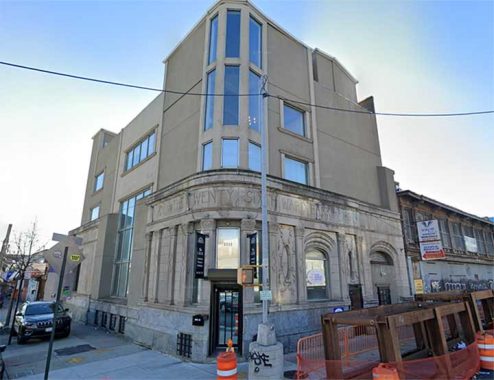
This defunct 26th Ward Bank, on Atlantic and Georgia Avenues in East New York (at the point where the “sunken section “flyover” section of Atlantic Avenue meets the surface road) , was built before consolidation in 1898, and so reflected that this was the local bank of the 26th Ward. New York City used to have political designations called wards, which were the smallest political units in NYC. Each ward elected an alderman and an assistant alderman to the City Council. According to The Encyclopedia Of New York City (1995, Yale University Press) the system goes all the way back to 1686, when Governor Thomas Dongan divided the city, then entirely in Manhattan, into six wards. In 1791, wards were given numerical designations. The First Ward was the tip of Manhattan, and districts were given consecutive numbers the further north you went in Manhattan. New wards were added as the city expanded northward, and increasing population of the older wards required subdivision. Brooklyn was also composed of wards. When it became a city in 1837, it was divided into nine wards, and by the time of consolidation with NYC in 1898 it had 32 wards. This former bank is one of the last tangible remnants of the old ward system. In 1999 I got some photos before a new building was kerplunked on top of it: fortunately, the old building was retained.
The bank was founded in 1889 by Ditmas Jewell, a prominent flour company president at the time, who hired architect J. Graham Glover to design the bank in 1891using granite, Indiana limestone, buff brick and terra-cotta. It’s original corner turret is long gone as is much of the building, save the curved section on the ground floor; fortunately that preserves its “26th Ward Bank” chiseled lettering. The bank, after multiple mergers, is now part of JP Morgan Chase.
The Queen of Brooklyn Architecture, Suzanne Spellen, has several photos of the building in its original condition in Brownstoner as does East New York Project, which inexplicably can be found at tapeshare.com.
Incidentally, this stretch of Atlantic Avenue has been a conduit for the Long Island Rail Road since the 1830s! It as run at grade (on the surface), on elevated tracks, and since the 1940s, in a tunnel — every modal possibility.
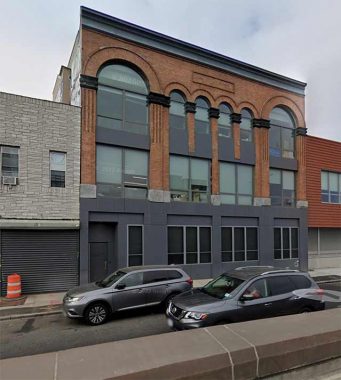
This impressive arched building across the street on the north side of Atlantic at Georgia was once Post Office Station E. I don’t have time to go down this particular rabbit hole, but while post office branches are most often given names, they also are sometimes given letters. For example, my former branch at 164th Street and Station Road in Flushing was simply “Station A” which was also the moniker given to the former post office that became Apple’s first retail store in Soho at Prince and Greene Streets.
There’s been quite a shift in architectural attitude at the SE corner of Atlantic and Pennsylvania Avenue from 2011 to 2024, as a handsome walkup apartment building, once the East New York Savings Bank, has been replaced by the East New York Health Hub, which resembles a cruise ship and is almost as big.
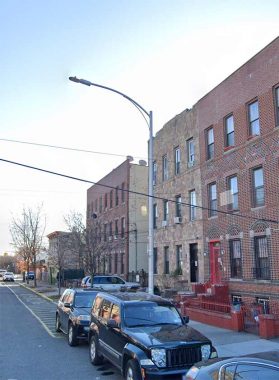
I noticed this curved-mast lamp on Bradford just south of Atlantic. When octagonal-shafted lampposts first began appearing in the early 50s, they all had curved masts with brackets like this, but where then replaced by straight masts and curved “cobra neck” masts. Few are left and I’m always glad to discover one I didn’t know about before.
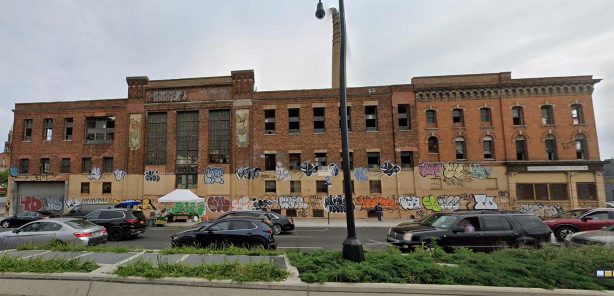
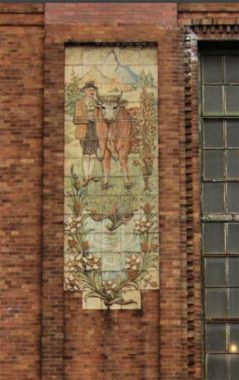
Pre-emptive apologies for showing the Empire State Dairy Company buildings at #2840 Atlantic Avenue between Schenck and Barbey Streets in their former decrepit condition — because the good news is that the buildings have been completely rehabilitated as can be seen on this recent Street View shot.
As is often the case, though, the rehabbing was done alongside the construction of new glassy residential towers above and behind it, one facing Barbey and the other, Schenck.
The original complex was constructed from 1907-1915 and contained bottling machinery for Empire State Dairy and later, Borden’s.
Of particular interest are a pair of beautiful terra cotta murals flanking the front entrance:
Unlike most factories, where functionality takes precedence over design, the buildings exhibit fine architectural details, including two remarkable terra cotta murals facing Atlantic Avenue. One depicts a woman leading a cow and a calf to water and the other depicts a man leading a bull to water. The characters in these scenes are set within bucolic, lush landscapes of water, meadows, pines and mountains, harkening to the agrarian beginnings of the dairy industry. The murals were manufactured by the American Encaustic Tiling Company, and are considered the largest extant decorative tile installations by the company. [New York Historic Districts Council]
In the most recent Street View photo, the murals are covered over: but I’d have to believe they were part of the restoration, as well.
|
|
|
|
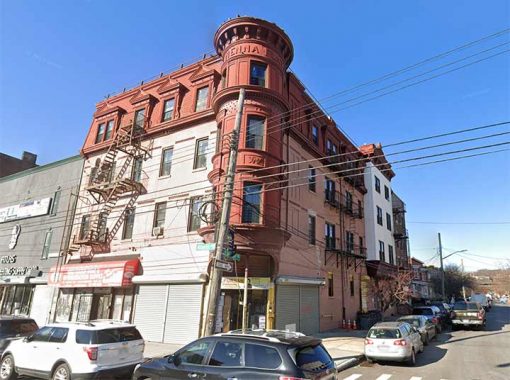
Vienna Flats, which is named at the top of the corner bay, was once one of the flagship apartment buildings in East New York when it was completed in 1890.
This Queen Anne style apartment building was commissioned one year before East New York was annexed as part of the City of Brooklyn. Upon its completion in 1890, it was the largest building in the area, designed to cater to small, working class families, with rental apartments advertised in the Brooklyn Eagle for $10.00 per month and up. Its Danish architect, William Danmar, was also an author, notable professor of architecture at Cooper Union and one of the founding members of the Architecture Department of the Brooklyn Institute of Arts and Sciences (precursor to the Brooklyn Museum). {Historic Districts Council]
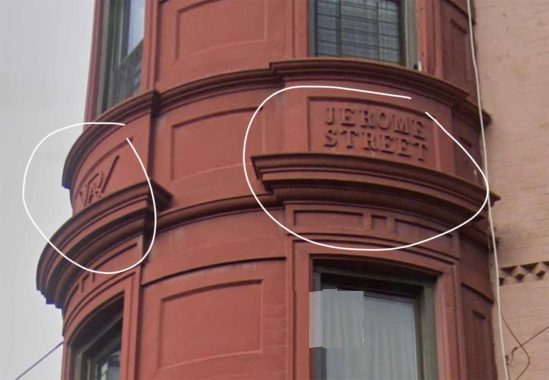
There’s a lot going on with the detailing: if you look above the second floor at the corner bay, you can see the two cross streets plus what looks like a digraph of WD, the architect’s initials.
Jerome Street, as you may guess, is named for financier Leonard Jerome, who was a racing fancier and built a Bronx racetrack where the Jerome Park Reservoir stands today. a much lengthier street, the Bronx’s Jerome Avenue, also has his name. Jerome is the grandfather of British statesman Winston Churchill and is buried in Green-Wood Cemetery.
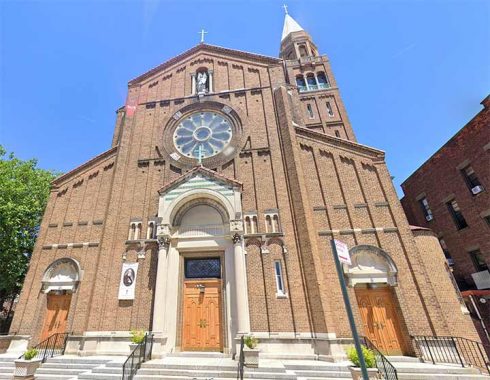
St. Michael’s Church, which was combined with the parish of St. Malachy in 2006, was founded about 1850, with this “new ” church was consecrated in 1922. Its school building at Warwick Street and Liberty Avenue is older as it was built in 1897, and a high school serving the parish was built in 1956 at Jerome Street and Liberty Avenue, and is now the Salve Regina Catholic Academy. Originally serving Irish and Italians, the parish now ministers to a Hispanic congregation for the most part.
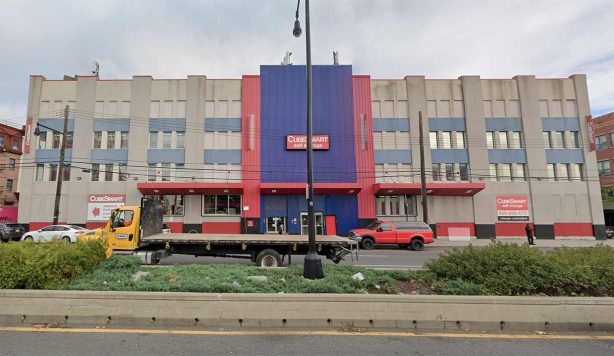
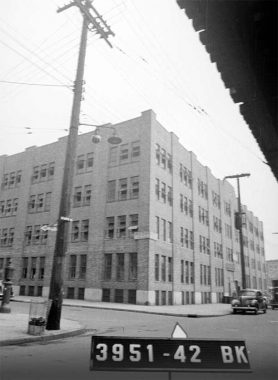
Presently a CubeSmart storage facility, this large building at #2887 Atlantic between Jerome and Warwick is tabbed as the Marvis Undergarment Co. and Atlantic Knitting Mills.
According to the East New York Project,
The building on the north side of Atlantic by Warwick was a fairly nondescript factory for Novocol Chemical- a manufacturer of Procain, the novocain used by dentists. Developed by a German scientist, the U.S. used to import it until World War I. At this point a license was issued in the U.S. to synthesize and produce the drug, and Novocol switched from importing to manufacturing.
|
|
|
|
|
|
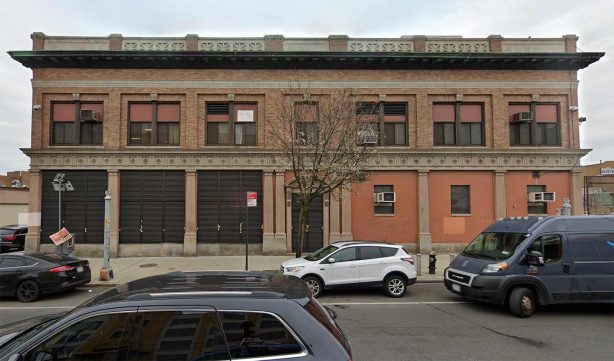
Presently the Cleveland Con Edison Cleveland Service Center at #2950 Atlantic between Ashford and Cleveland Streets, this handsome brick building was constructed as a “holding station” for Brooklyn Union Gas (now National Grid) massive tanks located behind the building.

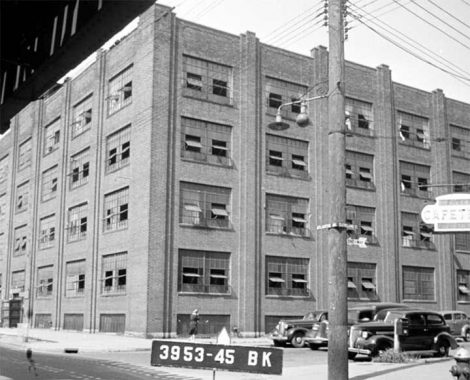
The Safeguard Self Storage building on the north side of Atlantic Avenue at Cleveland is much modified from how it looked in 1940. The 1929 Belcher Hyde atlas marks it as “J.D. Williams Inc.,” likely a manufacturer.
Note the radial wave incandescent, globular fire alarm indicator, and white one-way sign in the 1940 photo.
The Knorpp candy factory building still stands on the south side of Atlantic Avenue facing Essex Street, though its painted ad is long gone. Knorpp was in business from the 1910s into the 1960s; information about the company is scarce, but some items marketed by Knorpp are available on ebay.
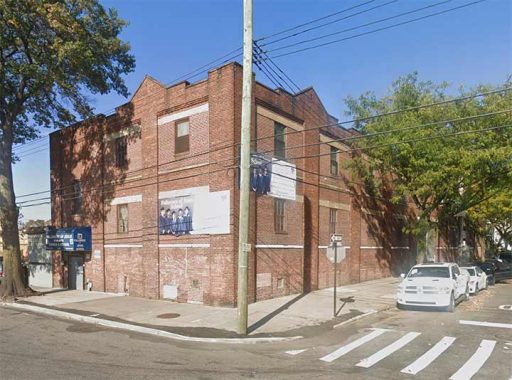
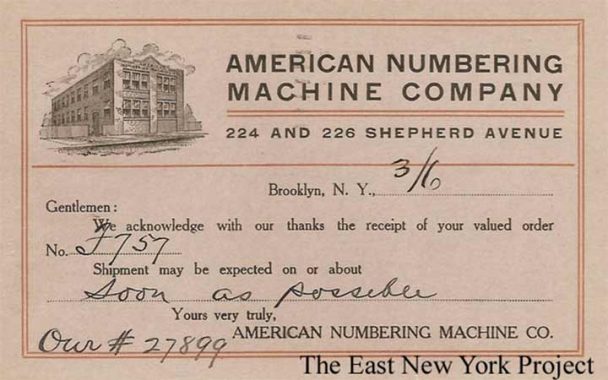
This nondescript brick building at the SW corner of Atlantic Avenue and Shepherd Avenue was once the headquarters of the American Numbering Machine Company. Numbering machines aren’t calculators (they were manufactured at a much later era) but a devices used for the rapid stamping or printing of consecutive numbers on successive pages, sheets, or discrete items. You have probably seen or used one.
One again, here’s a case of a Catholic school building much older than its church. St. Rita’s parish, oddly close to St. Michael’s, dates to the early 20th Century; the original brick church was replaced by this streamlined modern church building in 1963, but its 1925 school remains.
Margherita Lotti (1381-1457), known as St. Rita, was an arranged marriage to a violently tempered man whom she succeeded in reforming. Her sons were involved in the many feuding groups in the nation states which later became a united Italy, and her prayers for God to take them before they acted on murderous plans were answered. Rita’s story is inspirational for those of the Catholic faith. There is another St. Rita’s parish in Astoria, Queens.
Pennsylvania Avenue
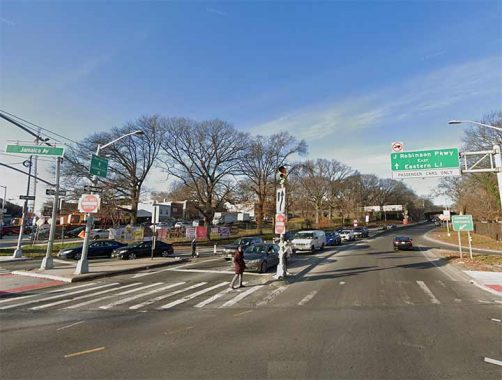
Brooklyn’s Pennsylvania Avenue isn’t as famed as the one several hundred miles south that features the White House and Capitol Building, but it’s an important north-south route connecting two major parkways built from 1932-1940: The Jackie Robinson (Interborough) Parkway, seen here at Pennsylvania, Jerome and Bushwick Avenues, which snakes its way NE to Forest Hills, where it meets the Van Wyck Expressway and Grand Central Parkway in a thicket of recently-rebuilt spaghetti ramps, and the Belt Parkway ringing the south end of Brooklyn and Queens. In 1997 the Interborough was renamed for Jackie Robinson, pioneering first African American to play in MLB and a six-time MLB All Star. He is buried in Cypress Hills cemetery, through which the parkway runs.
Pennsylvania Avenue is the most prominent of a group of “state avenues” in East New York that include Louisiana, Alabama, Georgia, New Jersey and Vermont. Why these states were selected to honor on the street map is impossible to say at this point. Brooklyn’s “state avenues” aren’t as prominent as its “cities of New York” avenues in Bedford-Stuyvesant and East Flatbush.
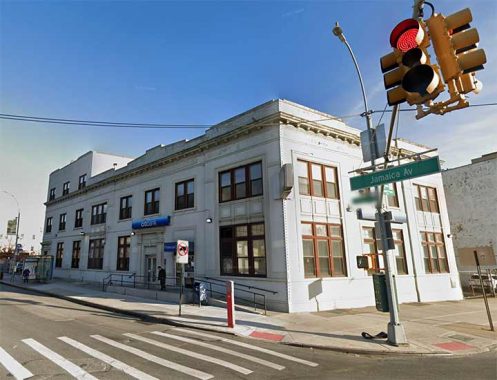
The prominent bank building on the SE corner of Pennsylvania and Jamaica, still with a functioning corner clock, is now part of the Citibank chain but was originally Citizens Bank of Brooklyn. I am unsure if this was part of the venerable Citizens Bank founded in the 1820s; in any case, that bank has a branch on Pennsylvania Avenue in Starrett City near the Belt Parkway.

Brooklyn Prince Hall Temple, #68 Pennsylvania avenue between Fulton Street and Atlantic Avenue, was constructed in 1906 as the Tyrian Masonic Lodge. In 1971, the building was acquired by the Prince Hall Masons, a Black Masonic auxiliary.
Prince Hall (1735-1808) was a Black Mason who was an activist for abolition of slavery and education rights for African American children. His birthplace in New England remains unclear, and tradition holds he was enslaved as a youth to a tanner, and taught himself reading and writing.
I have always remembered Hall because during one of my many visits to Boston beginning in the 1980s, I always stop in to Copp’s Hill Burying Ground in the North End and there, I found Prince Hall’s prominent gravesite.
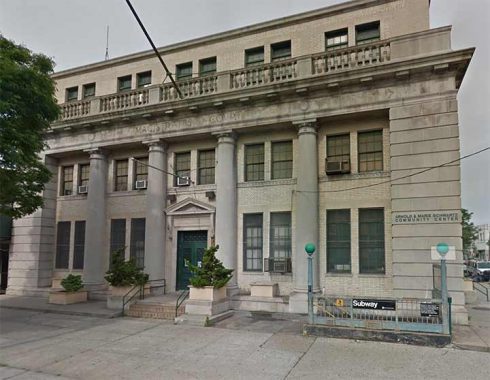
A pair of prominent buildings face off across Pennsylvania Avenue at Liberty Avenue. Mortimer Dickerson Metcalf designed this magistrate’s court building at #135 Pennsylvania which was used for low-level criminal cases until Brooklyn courts were consolidated in 1962. I can think of two other prominent magistrate’s court buildings: one in Park Slope, at 4th Avenue and 43rd Street, which has been repurposed, and another at Beach Channel Drive and Beach 91st Street, which has been rehabbed and in late 1924 was awaiting a tenant.
“Today it is home to the Police Athletic League, the Arnold and Marie Schwartz Community Center, and the offices for Community Board 5.” [Suzanne Spellen]
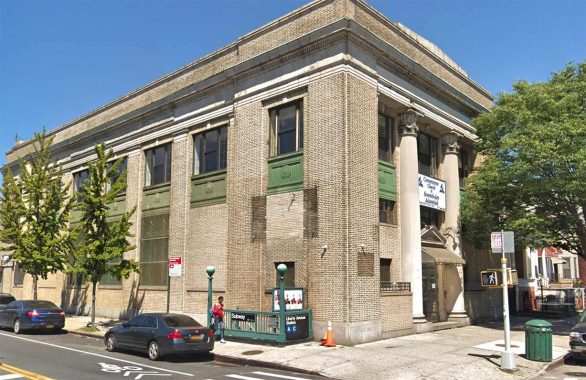
Directly across the street at #138 Pennsylvania is Homestead Branch of the National City Bank of New York constructed in 1922, designed by architect Frank Richards.
“There are windows on three sides, admitting real daylight into the tellers’ and bookkeepers’ cages. The finish of the cages is Tennessee marble and bronze. Metal desks that have the verisimilitude of mahogany harmonize with real mahogany trim and chairs.” [Brooklyn Eagle]
In 1977 the bank building was sold to Cornerstone Seventh-Day Adventist Church, which left it mostly intact.
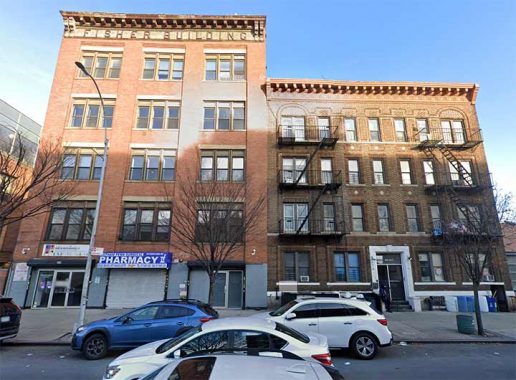
Fisher Building, Pennsylvania Avenue off Pitkin. Pennsylvania was once East New York’s premier north-south boulevard and many prominent, or formerly prominent, buildings, are found there.
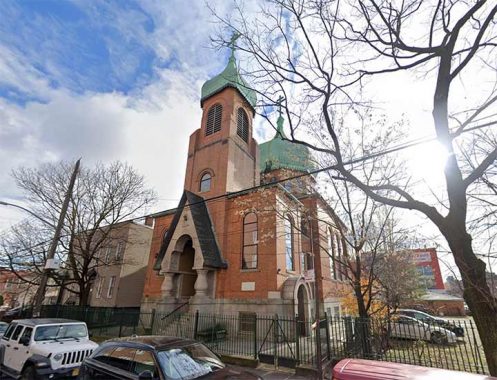
I like a good onion dome. They’re relatively few in NYC; I know about the Russian Orthodox Cathedral of the Transfiguration, on Driggs Avenue and North 12th Street in Greenpoint (seen on this page), and St. Nicholas Russian Orthodox Church on Clintonville street in Whitestone.
At Glenmore and Pennsylvania Avenue (Granville Payne Boulevard) is another great onion-dome, Holy Trinity Russian Orthodox Church. Believe it or not, it was built as late as 1935. East New York was famed for its Jewish complement in the early to mid 20th Century but there were also immigrants from Russia and what is now Belarus, who founded this congregation in 1909. the architect was Roman Meltzer, famed for his buildings in St. Petersburg. Russian immigrants have returned to East New York in recent years, giving added vitality to this congregation.
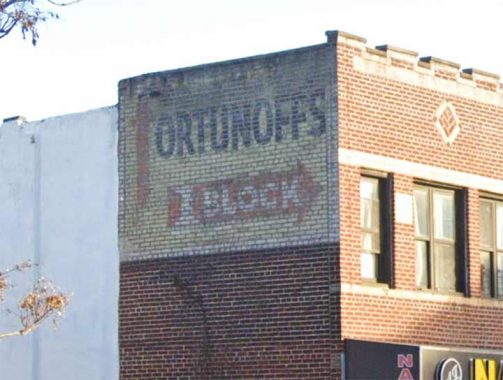
Fortunoff’s, the upscale Long Island store, got its start over 90 years ago as a dry goods concern in East New York, Brooklyn, at Pennsylvania and Livonia Avenues, and here’s a sign from (probably) the 1950s, when it was still there. Fortunoff’s went bankrupt in 2009 but has since operated as an online business. It’s amazing this painted sign on Pennsylvania south of Livonia has avoided getting painted over.
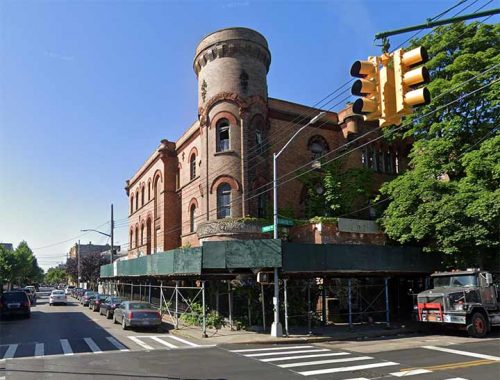
This abandoned castle of a police precinct at Liberty and Miller Avenues richly deserves recognition. Its architect George Ingram was a prolific designer of police stations in the pre-annexation City of Brooklyn. “Palatial Homes for the Wielders of the Club,” is how Brooklyn Daily Eagle described his stations. The 17th (originally 153rd) Precinct opened in 1892, with John Pocahontas Smith as its first detainee, arrested for public drunkenness. With a name like that, he either had Native ancestry or parents with a sense of historical humor. It functioned as a police station until the 1970s, when it was sold to People’s First Baptist Church; currently it is abandoned.
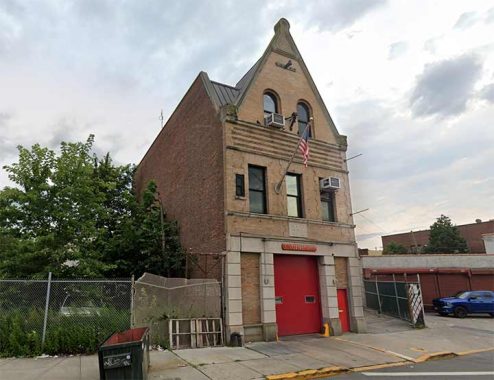
Engine Company 236, #998 Liberty avenue at Conduit Boulevard, was constructed in 1895 and its BFD trigram seen above the front entrance attest that Brooklyn had its own fire department before it joined Greater New York 3 years later. Many firehouses around town, especially the older ones, are distinctive indeed.
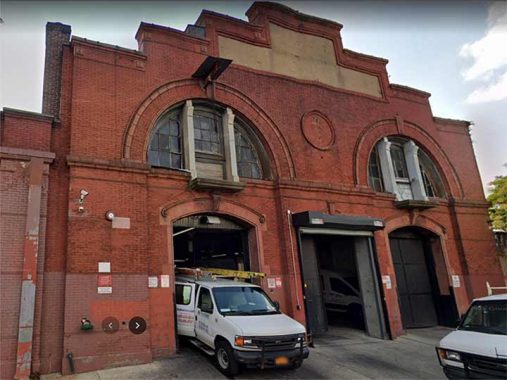
Former Piel’s Brewery, NW corner of Liberty and Sheffield Avenues. I discuss it on this FNY page, complete with an old Jimmy Breslin commercial.
Want to see more from East New York? These pages should help you there: Glenmore Avenue and Fulton Street.
Thanks to East New York Project, linked above, and Historic Districts Council Six to Celebrate, as well as Suzanne Spellen’s columns in Brownstoner.
As always, “comment…as you see fit.” I earn a small payment when you click on any ad on the site. Take a look at the new JOBS link in the red toolbar at the top of the page on the desktop version, as I also get a small payment when you view a job via that link.
12/8/24

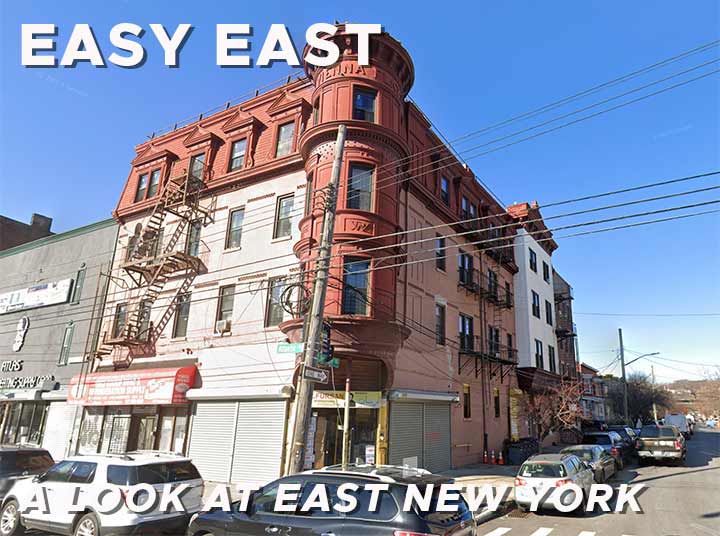
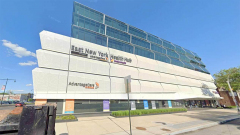
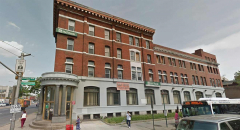
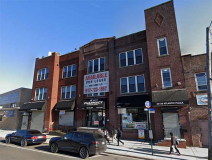
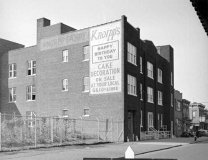
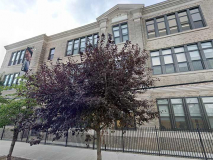
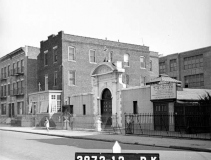
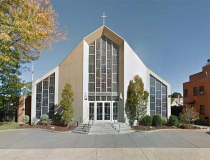
12 comments
My maternal roots go back to East New York. My grandmother lived on Schenck Avenue when she was a teenager (figure 1910-1915); close cousins lived for many years on Arlington Avenue at Warwick St. While it’s true that East New York has had its challenges since the 1960s, it’s good to see that there has been private investment in the area, as witnessed by the old Empire State Dairy Company buildings at #2840 Atlantic Avenue between Schenck and Barbey Streets. My grandmother walked those blocks as a young girl, when that building complex was brand new. Now I am the grandparent.
Lived Schenck and Blake from early 40’s to mid 50’s, lots of changes but great memories,
The street view of the Empire State Dairy buildings shows the terra cotta panels with a temporary covering, likely to protect them during the cleaning of the surrounding brick.
Sometime around the mid-50’s, our elementary school class (PS 121) took a “field trip” to the Borden’s factory on Atlantic Ave. We received ice cream in dixie cups and small containers of milk. However, Elsie was nowhere to be seen…
Wow,nice shot of the new uniforms of the Columbian Womens bicycle team.
This oughta liven things up around here!
“Columbian Women’s bicycle team”?! Where did you see that? Are you feeling well? Enlighten us by reproducing this “nice shot”
believe it or not ”the shot” was there,on the right side,on the main page.
Then I went away,came back,and it was gone.
Quite fetching uniforms I might add.They got a lot of controversy but the women
pictured in them seemed quite happy about them.
No idea what you guys are talking about–
Brooklyn’s State Avenues.
Most of the streets on the original 1835 John R. Pitkin map of East New York were named for states; Alabama, Georgia, Pennsylvania, New Jersey and Vermont Avenues running north and south, and Virginia (now Fulton Street), North Carolina (now Liberty) and South Carolina (now Glenmore) Avenues running east and west between Alabama and Wyckoff Avenues. (now Wyona Street) Two additional states were added circa 1869-74 when the Kings County Town Survey Commission laid out the streets in the Town of New Lots: Louisiana Avenue and Mississippi Avenue. It was about this time that Virginia, North Carolina and South Carolina Avenues were renamed Fulton, Liberty and Baltic (later Glenmore) respectively.
In 1886 New Lots Township was annexed to the City of Brooklyn, and in January 1887 the New Lots Board of Trade recommended to the Common Council the renaming of 67 streets in the former Town of New Lots, with the proposed names having the same initial letter as the original name. The name recommended for Mississippi Avenue was Mitchell Street; after considering the variant Mississippi Street the name Malta Street was chosen, and it was renamed by the Common Council on April 11, 1887, effective April 26, 1887. Vermont Avenue became Vermont Street under the same ordinance.
Pitkin Avenue was originally called Broadway; later renamed as an “extension” of Eastern Parkway on the 1869-74 Kings County Town Survey Commission map and made official after annexation to Brooklyn by the Common Council on April 11, 1887, effective April 26, 1887. Renamed as Pitkin Avenue by the Common Council on May 24, 1897, effective June 9, 1897.
It would indeed appear that the dairy murals have been retained, behind the covering, as one can still make them out if playing around in Street View. And even if the “new, glassy residential buildings” now loom behind and above the original building, the *smokestack* has also been retained! I wonder what that looks like from within the nearest apartments, and I wonder if its presence was cited as a “feature” (i.e., $$$), not a “bug”…
There was also a Magistrates Court on West 8th street between Surf and Neptune avenue in Coney Island when I was a child!
Thank you so much for all this information, so precious to keep an eye to this amazing heritage.